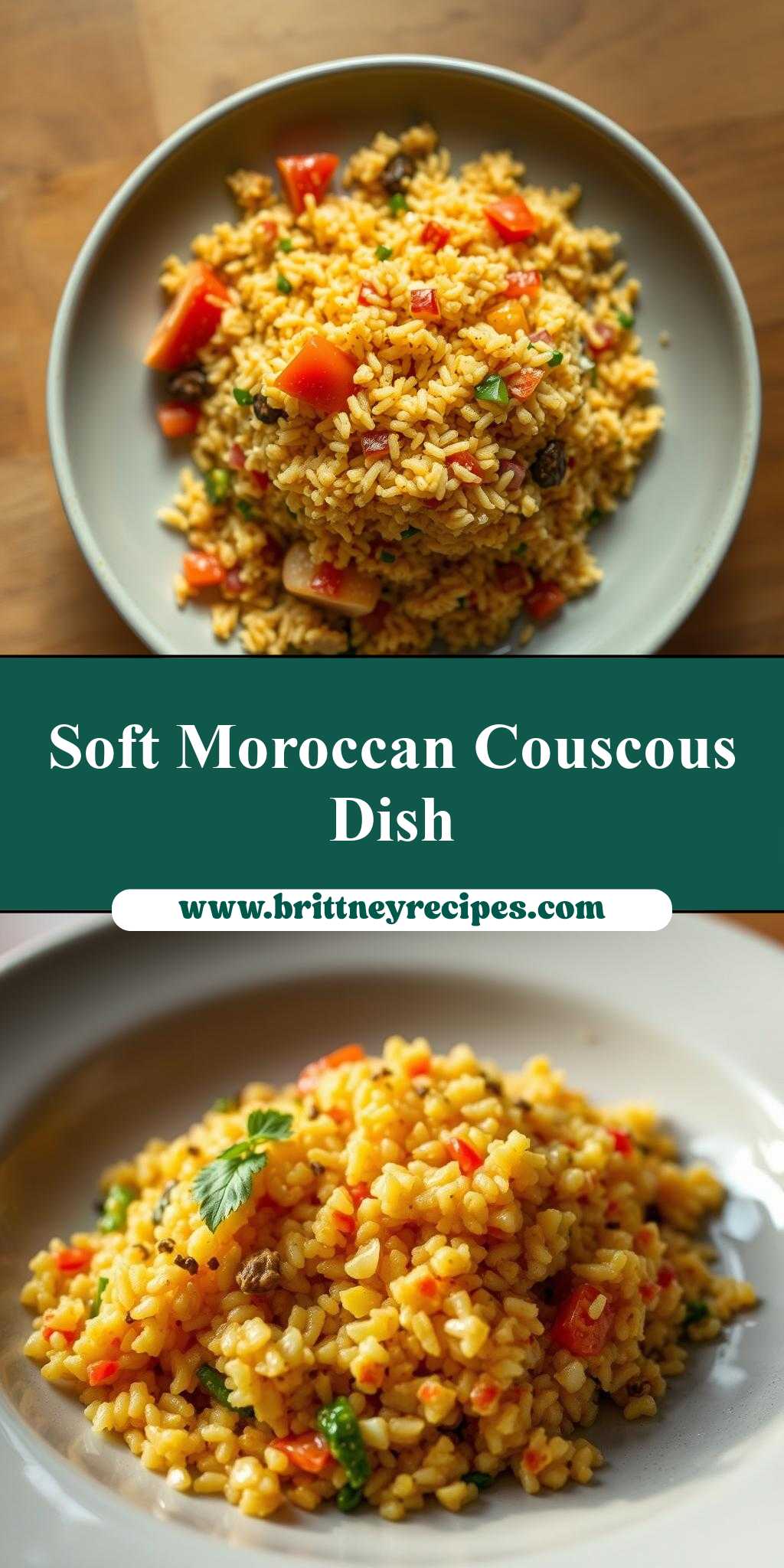What’s the secret to a truly authentic North African meal? It starts with traditional Moroccan couscous, a quick and easy homemade dish made with tender vegetables and flavorful chicken, perfect for a weeknight dinner. Save this idea for a delicious family favorite to enjoy later.
Traditional Moroccan Couscous
Introduction
Imagine a dish that is not only a staple of Moroccan cuisine but also a testament to the country’s rich culinary heritage. Traditional Moroccan Couscous is a flavorful, aromatic, and comforting meal that brings people together. This beloved North African dish is surprisingly easy to prepare, requiring minimal effort for a truly impressive and delicious outcome. With its perfect balance of flavors and textures, it’s a recipe that encourages creativity, using everyday ingredients to create something truly special. Whether you’re a seasoned chef or a culinary novice, this recipe is sure to become a favorite, offering a taste of Morocco’s vibrant culture with each delicious bite.
Why This Works
- Flavor balance and ingredient accessibility: The key to a great couscous dish lies in its balanced blend of spices, meats, and vegetables, all of which are readily available in most markets.
- Ease of preparation: Despite its complex flavors, Moroccan Couscous is surprisingly straightforward to prepare, making it perfect for both weeknight dinners and special occasions.
- Impressive results with minimal effort: The layering of flavors and textures in this dish creates a culinary experience that belies the simplicity of its preparation, making it an impressive addition to any meal.
Key Ingredients
The foundation of Traditional Moroccan Couscous includes couscous itself, a type of pasta made from crushed durum wheat semolina, water, and salt. Other main ingredients typically involve a combination of meats (lamb, beef, or chicken), a variety of vegetables (such as carrots, zucchini, and bell peppers), and a rich blend of spices including cumin, coriander, cinnamon, and turmeric. For those looking for substitutions, chicken or beef broth can be used in place of water for added flavor, and vegetables can be swapped based on seasonal availability and personal preference. The dish is also often flavored with preserved lemons and olives, which add a salty, tangy note to the couscous.
Instructions
- Step 1: Begin by preparing your ingredients. Chop the onions, slice the carrots and zucchini, and dice the bell peppers. Measure out your spices and have your meat ready for cooking.
- Step 2: Cook the couscous according to the package instructions, typically involving soaking it in boiling water, covering, and letting it steam for about 10 minutes, or until it’s light and fluffy.
- Step 3: In a large pot, heat a couple of tablespoons of olive oil over medium heat. Add the onions and cook until they’re translucent, then add the meat and cook until it’s browned. Next, add the sliced carrots, zucchini, and bell peppers, along with your blend of spices, and cook until the vegetables are tender.
- Step 4: To assemble the couscous, place a layer of the cooked pasta on a large platter or individual plates, followed by a layer of the meat and vegetable mixture. Repeat this process until all ingredients are used, finishing with a layer of couscous on top. Garnish with chopped fresh parsley, preserved lemons, and olives for added flavor and visual appeal.
Handy Tips
- When cooking the couscous, ensure that the water is boiling before adding it to the couscous to prevent it from becoming mushy. Also, be gentle when fluffing the cooked couscous with a fork to avoid breaking the grains.
- For vegetarians, the meat can be substituted with additional vegetables or tofu for a protein-rich alternative.
- Avoid overcooking the vegetables to preserve their texture and color, adding them to the pot based on their cooking times to ensure everything is tender but not mushy.
Heat Control
The ideal heat for cooking the meat and vegetable mixture is medium, allowing for a gentle browning of the onions and meat without burning, and a tender cooking of the vegetables without them becoming too soft. The cooking time will depend on the type and amount of meat and vegetables used, but generally, the mixture should be cooked for about 20-25 minutes, or until the meat is cooked through and the vegetables are tender.
Crunch Factor
Achieving the right texture in Moroccan Couscous is crucial, with the couscous itself being light and fluffy, and the vegetables retaining a bit of crunch. This balance of textures adds depth and interest to the dish. The crunch factor can be enhanced by adding some toasted almonds or pine nuts on top of the couscous before serving.
Pro Kitchen Tricks
- To enhance the flavor of the dish, use high-quality spices and consider adding a bit of smoky paprika for depth.
- For easier cleanup, line the pot used for cooking the meat and vegetable mixture with parchment paper or aluminum foil, making disposal of leftovers and cleaning much simpler.
- Consider preparing the components of the dish ahead of time. The meat and vegetable mixture can be cooked a day in advance and refrigerated overnight, making assembly and serving much quicker.
Storage Tips
- Leftover couscous can be stored in an airtight container in the refrigerator for up to 3 days. Reheat it by steaming or microwaving until warmed through.
- The meat and vegetable mixture can also be refrigerated for up to 3 days or frozen for up to 2 months. When reheating, ensure it’s heated through to a safe internal temperature to prevent foodborne illness.
- For the best results, store the cooked couscous and the meat/vegetable mixture separately to prevent the couscous from becoming soggy.
Gift Packaging Ideas
While Traditional Moroccan Couscous is typically served and enjoyed immediately, components of the dish can be packaged as gifts, such as jars of homemade preserved lemons, bags of specialty spice blends, or even containers of cooked, refrigerated or frozen couscous ready to be reheated. Consider decorative jars, colorful fabrics, and ribbons to add a personal touch to your gift.
Flavor Variations
- Different spices: Experiment with various spice blends, such as adding a bit of cayenne pepper for heat or using different types of paprika for smokiness.
- Creative toppings: In addition to traditional preserved lemons and olives, consider other toppings like diced fresh tomatoes, grilled halloumi cheese, or a dollop of tzatziki sauce for added creaminess.
- Ingredient swaps: Substitute chicken with lamb or beef for a different flavor profile, or use a variety of mushrooms for a vegetarian option.
Troubleshooting
- Texture problems: If the couscous becomes mushy, it may have been overcooked or the water ratio was incorrect. For the meat and vegetable mixture, ensure that ingredients are cooked according to their texture needs to avoid overcooking.
- Ingredient replacements: If a specific spice or ingredient is not available, look for substitutes that offer similar flavor profiles. For example, lemon juice can partially replace the flavor of preserved lemons.
- Over/undercooking signs: The couscous should be fluffy and separate, not clumpy or dry. The meat should be cooked through, and vegetables should be tender but still crisp.
FAQs
- Can I freeze it? Yes, both the cooked couscous and the meat/vegetable mixture can be frozen. However, it’s best to freeze them separately to maintain texture and flavor.
- Is it gluten-free? Traditional Moroccan Couscous is made from wheat semolina and is not gluten-free. However, there are gluten-free couscous alternatives made from corn, rice, or quinoa that can be used as substitutes.
- Can I double the recipe? Yes, the recipe can be easily doubled or tripled for larger gatherings. Just ensure that you have a large enough pot for cooking the meat and vegetable mixture and enough space for steaming the couscous.
Conclusion
Traditional Moroccan Couscous is a dish that embodies the warmth and hospitality of Moroccan culture, offering a rich tapestry of flavors and textures that are sure to delight both the palate and the senses. With its ease of preparation, impressive presentation, and the flexibility to adapt to various tastes and dietary needs, it’s a recipe that encourages creativity and sharing. Whether you’re cooking for a family dinner or a special occasion, this timeless dish is sure to become a favorite, transporting you and your guests to the vibrant souks and bustling kitchens of Morocco with each delicious serving.

